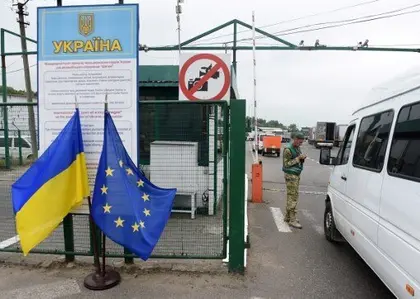In response to Russia’s military build-up at the Ukrainian border, several western embassies have reached out to their citizens with travel advisories and other recommendations.
At least two, the United States and Canada, have urged their citizens residing in Ukraine to leave immediately while commercial flights and other means of transportation are still available.
Ukraine’s Foreign Ministry has called such advice “premature.”
Meanwhile, Ukraine’s Culture and Information Policy ministries in June published a booklet that provides detailed contingency advice while the Kyiv Post researched border crossings to five neighboring countries in the west. A link is provided below to where bomb shelters in Kyiv are located.
Embassy Advice
France
In late January, French Ambassador Etienne de Poncins sent an email to compatriots, noting that the Crisis and Support Center in Paris has considered all scenarios, including the most worrying ones, and is thus fully prepared.
The embassy encourages all French citizens to register with the French government, have valid identity documents, warm clothes, supplies of water and food at hand. Travelers are advised to register on the Ariane portal.
Britain
The Foreign, Commonwealth and Development Office (FCDO) advises against all travel to Donetsk and Luhansk oblasts as well as all but essential travel to the rest of Ukraine. It cited Russian military deployments since March 2021 and evidence of heightened tensions between Russia and Ukraine.
According to the FCDO, the situation in Kyiv and other areas outside Donetsk and Luhansk is “generally calm,” yet has the potential to deteriorate quickly and without warning. U.K. citizens are also encouraged to register with the FCDO via this link. A registered British citizen told the Kyiv Post he so far has “not received any information advising evacuation.”
Canada
Canada’s authorities recommend avoiding all travel to Ukraine due to ongoing Russian threats and the risk of armed conflict. They advise Canadian citizens to leave, noting that the decision to travel is their choice and they’re responsible for their own safety abroad.
“If you are in Ukraine, you should leave while commercial means are available,” reads an email sent by Canada’s Global Affairs department in a bright red font.
“You should not depend on the Government of Canada to help you leave the country,” it continued in red. “Be prepared to shelter in place.”
United States
At a virtual town hall meeting held last month, the U.S. Embassy advised its citizens to also leave “while commercial flights are still available.” Periodic messages sent to registered citizens have cited reports that Russia is planning significant military action against Ukraine and unpredictable security conditions.
The State Department asks that all U.S. citizens in Ukraine complete an online form so that it may better communicate with them.
Germany
Germany’s Federal Foreign Office advises its citizens to check their travel plans and postpone non-essential travel if necessary against the background of the current Russian military movements near Ukraine’s state borders.
Germans are advised to follow current developments in international and local media, and too pay attention to local announcements, especially regarding the security situation.
It also encourages citizens to subscribe to the crisis prevention list of the Federal Foreign Office.
Ukrainian contingency booklet
A 14-page specialized brochure, titled If There is a State of Emergency or War, provides detailed contingency plans for civilians. It was published in June 2021 by the Center for Strategic Communications and Information Security at the Ministry of Culture and Informational Policy.
It recommends the following:
- Prepare a bag with essential belongings. It should include 72 hours’ worth of water and pre-cooked food, a passport and other types of identification as well as documents certifying property ownership, cash, bank cards and phone chargers.
- Miscellaneous items include a radio, flashlight, compass, watch, multi-tool, knife, trash bags, notebook, pencils, needles, thread, lighter and matchsticks. Also pack warm clothes, underwear, comfortable footwear, personal hygiene products, medication, and cooking plates.
- A first-aid kid should include dry and medical alcohol, 2 pairs of rubber gloves, elastic bandages, resuscitation aid with a valve, scissors for cutting clothes, different-sized gauze patches, a clean cloth, tissue, or piece of gauze to stop bleeding, a large piece of tissue that can be used to fix a victim’s limb and antiseptics.
- Locate the nearest bomb shelter in advance. Type an enquiry in Ukrainian or Russian that reads “укриття в <insert town>” or “укрытие в <insert town>” to find an interactive map online. The Kyiv city map is available here.
- If a loud, recurring alarm is heard outside, it means that official TV or radio channels should immediately be turned on – either offline or online – such as the Suspilne TV channel and wait for further instructions from the authorities.
- If deciding on moving to a different locale, make sure to have enough gas and a paper map handy. Store identification and money in different places.
- Make sure to indicate your blood group and potential allergies. Before leaving, cut off electricity, water, and gas supplies, close all the windows and cover the ventilation holes, grab respirators, and the bag with essentials. If help is needed leaving the residence, place a white piece of clothing outside a window or attach it to a door handle.
- Children should have information on them in case they get lost, including their full name, date of birth, permanent address and destination. Check evacuation routes in advance and available transportation.
- If sheltering in place, make sure to have alternative heating methods, sufficient provision, and fire extinguishers. Use sticky polymer tape to cover window frames from shattered glass. Also, cover door gaps and ventilation holes with pieces of clothes and paper.
- If shelling occurs, hide in the bathroom, or run to the nearest bomb shelter immediately. Do not stand next to the windows. If outdoors when the shelling starts, look for signs that read “Укриття” and remain there until the shelling stops. Alternatively, find some kind of holes in the ground where you can hide and cover your head. Do not hide behind cars or kiosks.
- Filter information sources. Information is critical in times of war. Do not communicate with strangers, tell them about your plans, the movement of the military, etc. Listen only to official and trusted sources.
Leaving Ukraine via land crossing
Ukraine borders five countries in the west: Poland, Hungary, Slovakia, Romania and Moldova. All but Moldova are EU member states.
Poland, Hungary and Slovakia are also Schengen states. This means that for some citizens, a Schengen visa is required to enter unless the passport holder qualifies for a Schengen visa waiver.
Another exception is if the traveler is a citizen or a resident (temporary or permanent) of an EU/Schengen member state. Complete entry rules, including COVID-19 pandemic-related ones, are available on the Schengen visa information site.
There are 26 checkpoints between Ukraine and the above-mentioned Schengen countries. They are in three regions: Volyn, Lviv and Zakarpattya (Transcarpathia). Most of them are located at the Ukraine-Poland border and can only be crossed in a vehicle.
Please note that U.S. citizens are not allowed to enter Poland using ground transportation. Only three UkraineSchengen crossings are available for pedestrians: Shehyni (at the Polish border with Lviv region), and Mali Selmentsi and Malyi Bereznyi (at the Slovakia border in Zakarpattya region).
All of them are heavily congested in normal times and apart from several crossings such as, Shehyni, have limited infrastructure and poor roads, so keep that in mind.
In the southwest, Ukraine has 10 and 54 border crossings for individual travelers entering Romania and Moldova, respectively. They are located in the Zakarapttya, Chernivtsi, Odesa, and, in Moldova’s case, Vinnytsya regions as well.
Among all the bordering countries, Moldova has the biggest number of options for crossing the border on foot.
The entry requirements are available via the Romanian Ministry of Foreign Affairs (coronavirus requirements were last updated on Dec. 17, 2021) and Moldova’s Ministry of Foreign Affairs.
Note that starting on Jan. 17, Moldova allows entry to all citizens as long as they can present a vaccination certificate, a negative COVID-19 test in the last 180 days, a test of antibodies in the in the last three months, and an express test taken in the last 48 hours or a PCR test in the last 72 hours.
A detailed interactive map from the Ukrainian State Border Guard Service provides the exact locations of all the border crossings.
You can also highlight the text and press Ctrl + Enter




